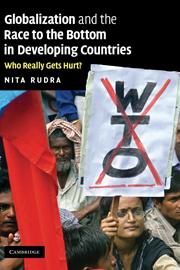Book contents
- Frontmatter
- Contents
- List of figures
- List of tables
- Preface
- 1 Introduction
- 2 The race to the bottom in developing countries
- 3 Who really gets hurt?
- 4 LDC welfare states: convergence? What are the implications?
- 5 Globalization and the protective welfare state: case study of India
- 6 Globalization and the productive welfare state: case study of South Korea
- 7 Globalization and the dual welfare state: case study of Brazil
- 8 Conclusions
- Appendix A LDC social spending
- Appendix B Assessing potential labor power
- Appendix C Additional tests for the RTB hypothesis
- Appendix D Variables in the inequality model
- Appendix E Technical notes on Gini coefficients
- Appendix F LDC Gini coefficient statistics
- Appendix G Robustness check
- Appendix H Conditional impact of trade on inequality
- Appendix I Descriptions and sources of variables
- Appendix J Cluster results minus outcome variables
- Appendix K Dendrogram for cluster analysis
- Appendix L Poverty tables
- Appendix M Social expenditures on social security, health, and education in India (percent of GDP) based on national data
- References
- Index
6 - Globalization and the productive welfare state: case study of South Korea
Published online by Cambridge University Press: 22 September 2009
- Frontmatter
- Contents
- List of figures
- List of tables
- Preface
- 1 Introduction
- 2 The race to the bottom in developing countries
- 3 Who really gets hurt?
- 4 LDC welfare states: convergence? What are the implications?
- 5 Globalization and the protective welfare state: case study of India
- 6 Globalization and the productive welfare state: case study of South Korea
- 7 Globalization and the dual welfare state: case study of Brazil
- 8 Conclusions
- Appendix A LDC social spending
- Appendix B Assessing potential labor power
- Appendix C Additional tests for the RTB hypothesis
- Appendix D Variables in the inequality model
- Appendix E Technical notes on Gini coefficients
- Appendix F LDC Gini coefficient statistics
- Appendix G Robustness check
- Appendix H Conditional impact of trade on inequality
- Appendix I Descriptions and sources of variables
- Appendix J Cluster results minus outcome variables
- Appendix K Dendrogram for cluster analysis
- Appendix L Poverty tables
- Appendix M Social expenditures on social security, health, and education in India (percent of GDP) based on national data
- References
- Index
Summary
What are the effects of globalization on productive welfare states? In contrast to protective welfare states, such as India's, are they advancing towards the neoliberal bottom? Who gets hurt from changes in welfare policies as markets expand in productive welfare states? Using details from the case of South Korea, this chapter seeks to answer these questions by illustrating how the interplay of international markets and domestic institutions shapes social policies in a productive welfare state. Just as in protective welfare states (e.g. India), globalization pressures are real and have prompted cutbacks in several of South Korea's welfare programs. At the same time, the South Korean government has also explored ways to make the productive welfare state more “protective.” The introduction of universal pensions and health insurance constitutes two examples. This is very distinct from India, a protective welfare state, where the (relatively) major path-breaking reforms have been in the “productive” welfare category (e.g. education). Despite succumbing to some race to the bottom pressures, however, the main features of South Korea's productive welfare state remain intact: promoting citizens' market reliance through extensive state intervention and a concentration of public resources on commodification, particularly education. As a result, the situation of better-off groups in society is similar for both regime types: long-standing domestic institutions essentially guarantee that the more privileged sectors will have access to protections from the risks and uncertainties associated with the globalizing environment.
- Type
- Chapter
- Information
- Globalization and the Race to the Bottom in Developing CountriesWho Really Gets Hurt?, pp. 142 - 176Publisher: Cambridge University PressPrint publication year: 2008

